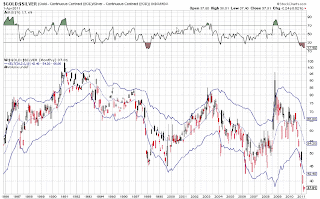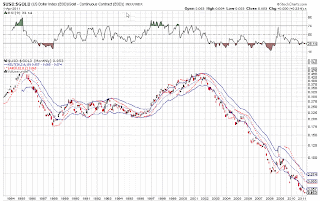Well we are seeing an unusual situation where the ratio of how many ounces of silver we can buy with 1 ounce of gold has continued to drop pretty quickly. The chart below is the update as of this weekend (click for bigger). It is currently at a ratio of about 1:38, which simply means that is how many ounces of silver you can buy with 1 ounce of gold. In my Gold! No wait, silver! Feb 20 post the ratio was about 1:44.
I've noticed when prices or ratios get out of the average range (the blue band that the ratio usually stays within) as they are now, what typically happens is a "correction to the mean", ie the ratio comes back within the band. Another thing I've noticed is when prices or ratios come way out of range they tend to correct to the mean by going outside the band in the opposite direction. Notice the black bar going way out of the top of the band in the latter part of 2008? That was the financial panic and market crash of 2008 when folks were loading up on gold way more than they were buying silver. We seem to be correcting that "imbalance" of the mean by going outside the band on the other side.
The reason the ratio of gold to silver price spiked to about 1:97 in the 2008 crash is because when people are panicking about their net worth rapidly declining (crashing) they want gold as the safe haven. Of course, more purchases of gold drives its price up, and less purchases of silver drives it's price down.
The reason people wanted gold during a financial panic is because throughout history gold has been thought of as the most stable "store of value" available. Even as it's price in US Dollars fluctuates, what you can buy at any given time with an ounce of gold (converted into dollars at the moment of purchase) actually does not fluctuate all that much. That stable "value" of gold has been an ongoing historic phenomenon since Roman times.
Back in the old days when gold coins were the primary form of money being used, governments in debt trouble (because they spent more than they were bringing in) would often add some type of base metal to the gold coins but not change the nominal value of the coin. It was (and is) called debasement of the currency. However folks with product and services to sell would quickly discern the ruse and demanded more of the debased coins for the same product/service. All they really asked for was the same amount of gold as before.
Shrewd business people aren't fooled by debasement of currencies by governments trying to wiggle out of their debt responsibilities, and so they ask for more of the debased currencies in proportion to the level of debasement. A coin debased of all gold content would only be worth whatever the copper or bronze was selling for on the market at that time. Whereas a Roman citizen may have only needed a few dozen gold coins for a nice new chariot, they would have needed a wheelbarrow full of them when they were fully debased.
Of course modern governments decided they didn't want to have to be enslaved by "honest money" (gold) so they completely debased the currency in perpetuity by removing the convertible feature whereby your paper money could be converted directly to gold or silver. A dollar was redeemable for one ounce of silver (the silver dollar).
When paper currencies are completely unlinked what are they worth? The "full faith and credit" of the issuing government. But what if that government is in debt up to it's eyeballs, more than they are taking in, so much they cannot even keep up with the interest payments on what they owe? How much faith are shrewd business people going to have in the paper money issued by that government?
Then, if that weren't enough to erode "faith", that same indebted government decides to just create more money so that they can at least keep up with interest payments. They have to do that or the government cannot borrow new money to cover ongoing and increasing expenses, and then that government will cease efficient functioning. And after all since the paper money is not linked to anything of stable value, all they have to do is print more of the stuff.
There are other things of stable value, a given quantity of food can be exchanged for a given quantity of clothing, for example, on a barter, and that relationship is historically stable. The value of gold as money has a lot to do with it's relative durability, and portability.
Yes, it is true, governments are comprised of people, and so like individuals are capable of engaging in wishful thinking. When this happens, but shrewd business people aren't fooled, and the government prints more and more to keep up with ramping costs, a runaway spiral can start.
Well guess what there's an easy way to keep track of the level of wishful thinking a government is engaged in regarding it's net worth, and the subsequent ongoing value of the "faith" held in it, by simply looking at the value of gold, in comparison.
Gold doesn't really change in value in terms of what can be procured with an ounce of it, but the dollar does, the value of paper money only goes down! This is another thing that has always been true throughout history. So, as the value of the dollar goes down, the price of everything else goes up. But you can measure the change by seeing the change in stable value gold. If the price of gold doubles in three years, the value of the dollar halved in that same time. This correlation is not exact moment by moment, but averages over time.
Here's a picture of the ratio of dollars to gold, or in other words, the decline of the purchasing power of the dollar. Since about the time of the market crash of 2000 (tech wreck), the US gov began debasing dollar value by printing more of them, in an attempt to keep up with the existing and new debt necessary for continuing gov operations.


No comments:
Post a Comment